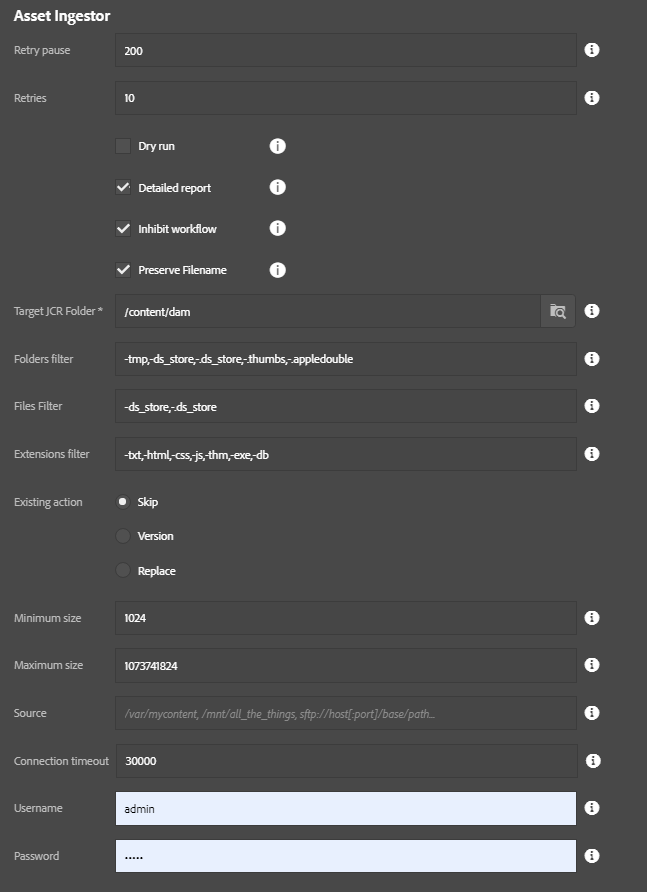Asset Ingestor
Available since version 3.10.0
AEM as a Cloud Service incompatible!
This feature is not AEM as a Cloud Service compatible, and can only be used on AEM 6.5.
This is an example of a high-speed parallel asset ingestor utility. You can load a directory of assets into AEM very easily with this tool. Because of the ability to overload a server with assets, this tool only appears for the “admin” user right now.

- Retry pause: Used as retry pause between createFolder, createAsset actions and etc…
- Retries: Actions to attempt.
- Dry run: If checked, no assets will be imported but a report will be produced. This is useful for testing out the data file for integrity.
- Detailed Report: If checked, a list of all imported assets will be produced. If unchecked, only a summary will be provided.
- Inhibit Workflow: If checked, the process will attempt to bypass DAM Update Asset workflow. This requires the workflow launcher have the following in the exclude list setting:
event-user-data:changedByWorkflowProcess. If using this option. also consider using bulk workflow afterwards to process assets after the import has finished completely. - Preserve Filename: If checked, file name is preserved as asset name. If unchecked, asset name will support only the following characters: letters, digits, hyphens, underscores, another chars will be replaced with hyphens.
- Target JCR Folder: Where to store the assets in AEM
- Folders filter: Comma-delimited list of folders to filter, useful for bypassing thumnail folders and such. If you want to exclude folder name add ‘-‘ sign before name. If you want to include name, just write folder name or add ‘+’ sign before name.
- Files filter: Comma-delimited list of files to filter, also useful for bypassing additional metadata files which might not be useful in a DAM setting. If you want to exclude file name add ‘-‘ sign before name. If you want to include name, just write file name or add ‘+’ sign before name.
- Extensions filter: Comma-delimited list of file extensions to filter. If you want to exclude extension add ‘-‘ sign before name. If you want to include extension, just write extension or add ‘+’ sign before name.
- Existing action: Decide what should happen if the DAM contains a target file already, such as if the ingestion is resumed after a previous abort
- Replace: Replace the asset already in AEM (this can slow things down compared to skip)
- Skip: Skip the asset
- Version: Create a version of the asset and upload a fresh copy. This is the safest, but slowest, option.
- Minimum size: The minimum file size (in bytes) that is required for importing a file. Anything smaller is ignored. (0 = no minimum)
- Maximum size: The maximum file size allowed (in bytes); anything larger is skipped. (-1 = no maximum – NOT RECOMMENDED!)
- Source: Source folder for content ingestion which can be a local folder or SFTP url.
- Connection timeout: For SFTP urls, this is the connection timeout in milliseconds (default is 30 seconds)
- Username: Username for SFTP connection
- Password: Password for SFTP connection
This process has two steps:
- Create folder structure
- Import assets